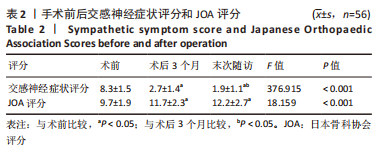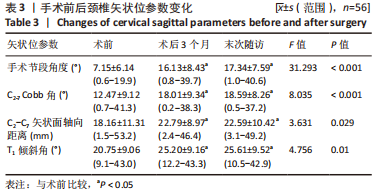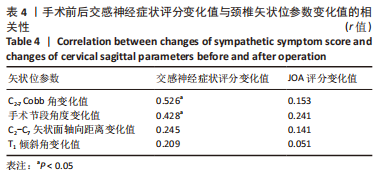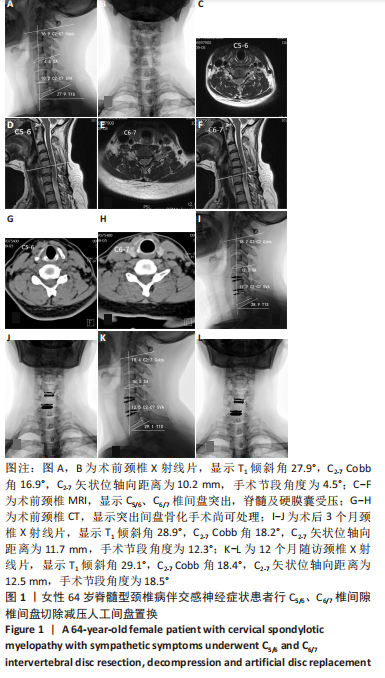[1] 郝尹泽,刘松旗,李庆达.后路经皮内镜下颈椎间盘切除术与传统前路颈椎间盘切除融合术治疗神经根型颈椎病临床疗效的Meta分析[J].中国骨与关节杂志,2022,11(9):668-675.
[2] 雷润博,李盼,甘璐,等.单节段Discover人工颈椎间盘置换术与颈前路减压融合术治疗颈椎病的长期疗效对比[J].中国脊柱脊髓杂志,2022,32(8):688-695.
[3] AZIMI P, YAZDANIAN T, BENZEL EC, et al. Sagittal balance of the cervical spine: a systematic review and meta-analysis. Eur Spine J. 2021;30(6): 1411-1439.
[4] 中华外科杂志编辑部.颈椎病的手术治疗及围手术期管理专家共识(2018)[J].中华外科杂志,2018,56(12):881-884.
[5] 中华外科杂志编辑部.颈椎病的分型、诊断及非手术治疗专家共识(2018)[J].中华外科杂志,2018,56(6):401-402.
[6] 袁文,梁磊,王新伟.对伴交感神经症状颈椎病的认识与治疗探讨[J].中国脊柱脊髓杂志,2013,23(1):3-5.
[7] EPSTEIN NE. A Review of Complication Rates for Anterior Cervical Diskectomy and Fusion (ACDF). Surg Neurol Int. 2019;10:100.
[8] XIE L, LIU M, DING F, et al. Cervical disc arthroplasty (CDA) versus anterior cervical discectomy and fusion (ACDF) in symptomatic cervical degenerative disc diseases (CDDDs): an updated meta-analysis of prospective randomized controlled trials (RCTs). Springerplus. 2016; 5(1):1188.
[9] HIRVONEN T, MARJAMAA J, SIIRONEN J, et al. Young adults undergoing ACDF surgery exhibit decreased health-related quality of life in the long term in comparison to the general population. Spine J. 2021;21(6): 924-936.
[10] 薛睿,申勇,王林峰,等.伴交感神经症状的脊髓型颈椎病前路手术中切除后纵韧带的早期疗效研究[J].中华骨科杂志,2013,33(2): 105-110.
[11] LI J, GU T, YANG H, et al.Sympathetic nerve innervation in cervical posterior longitudinal ligament as a potential causative factor in cervical spondylosis with sympathetic symptoms and preliminary evidence. Med Hypotheses. 2014;82(5):631-635.
[12] STEGMANN T, STEINKE H, PIEROH P, et al. On the importance of the innervation of the human cervical longitudinal ligaments at vertebral level. Surg Radiol Anat. 2020;42(2):127-136.
[13] LV B, FAN X, DING H, et al. Analysis of Correlation Between Age and Cervical Facet Joint Degeneration and Modic Changes in Patients with Cervical Spondylotic Myelopathy. Med Sci Monit. 2019;25:7882-7888.
[14] WU X, WANG X, ZHANG G, et al. Histologic Observation and Significance of Sympathetic Nerve Fiber Distribution on Human Cervical Ligamentum Flavum. Orthop Surg. 2020;12(6):1811-1825.
[15] LEE JH, CHENG KL, CHOI YJ,et al. High-resolution Imaging of Neural Anatomy and Pathology of the Neck. Korean J Radiol. 2017;18(1):180-193.
[16] PENG B. Cervical Vertigo: Historical Reviews and Advances. World Neurosurg. 2018;109:347-350.
[17] LUBELSKI D, RAMHMDANI S, PENNINGTON Z, et al. Utility of Posterior Longitudinal Ligament Resection During Anterior Cervical Decompression for Radiculopathy. World Neurosurg. 2020;137: e425-e429.
[18] SHAO F, BAI H, TANG M, et al. Tissue discrimination by bioelectrical impedance during PLL resection in anterior decompression surgery for treatment of cervical spondylotic myelopathy. J Orthop Surg Res. 2019;14(1):341.
[19] REDDY RS, TEDLA JS, DIXIT S, et al. Cervical proprioception and its relationship with neck pain intensity in subjects with cervical spondylosis. BMC Musculoskelet Disord. 2019;20(1):447.
[20] YANG TH, XIRASAGAR S, CHENG YF, et al. Association of Cervical Spondylosis With Peripheral Vertigo: A Case-Control Study. Laryngoscope. 2021;131(2):E625-E630.
[21] KHAN S, HAMEED N, MAZAR S, et al. Persistent Shoulder Pain After Anterior Cervical Discectomy and Fusion (ACDF): Another Dual Pathology. Cureus. 2021;13(3):e13709.
[22] LOMBARDI JM, VIVAS AC, GORNET MF, et al. The Effect of ACDF or Arthroplasty on Cervicogenic Headaches: A Post Hoc Analysis of a Prospective, Multicenter Study With 10-Year Follow-up. Clin Spine Surg. 2020;33(9):339-344.
[23] 冉宇,白春晓,刘楚吟,等.单节段Mobi-C人工间盘置换与ROI-C颈椎前路融合后颈椎矢状位参数的变化[J].中国组织工程研究, 2023,27(27):4297-4303.
[24] 周世博,赵学千,袁林,等.颈前路椎间盘切除减压融合联合颈椎间盘置换对三节段颈椎病矢状位指标的影响[J].中国中医骨伤科杂志,2022,30(9):47-52.
[25] 朱金亚,汪乃钱,朱若清,等.探讨基于脊神经定位的颌枕牵引治疗神经根型颈椎病临床疗效观察[J].医学理论与实践,2022,35(11): 1874-1876.
[26] PENG Z, HONG Y, MENG Y, et al. A meta-analysis comparing the short- and mid- to long-term outcomes of artificial cervical disc replacement(ACDR) with anterior cervical discectomy and fusion (ACDF) for the treatment of cervical degenerative disc disease. Int Orthop. 2022;46(7):1609-1625.
[27] CALLANAN G, RADCLIFF KE. Cervical Total Disc Replacement: Long-Term Outcomes. Neurosurg Clin N Am. 2021;32(4):461-472.
[28] HONG L, KAWAGUCHI Y. Anterior cervical discectomy and fusion to treat cervical spondylosis with sympathetic symptoms. J Spinal Disord Tech. 2011;24:11-14.
[29] 钟卓霖,胡建华,翟吉良,等.伴随颈椎病颈性眩晕的手术治疗[J].中华医学杂志,2015,95(25):2014-2017.
[30] AVILA MJ, SKOCH J, SATTAROV K, et al. Posterior longitudinal ligament resection or preservation in anterior cervical decompression surgery. J Clin Neurosci. 2015;22(7):1088-1090.
[31] 牛朋彦,王依宁,李亮,等.PEEK椎间融合术治疗伴交感神经症状颈椎病的疗效分析[J].颈腰痛杂志,2020,41(4):473-474.
[32] QIAN J, TIAN Y, QIU GX, et al. Dynamic Radiographic Analysis of Sympathetic Cervical Spondylosis Instability. Chin Med Sci J. 2009;24(1): 46-49.
[33] CHEN X, WANG G, QIN YT, et al. Clinical significance of microsurgical excision of the posterior longitudinal ligament using a high-frequency electrosurgical excision procedure in anterior cervical discectomy and fusion. Wideochir Inne Tech Maloinwazyjne. 2019;14(4):575-580.
|









